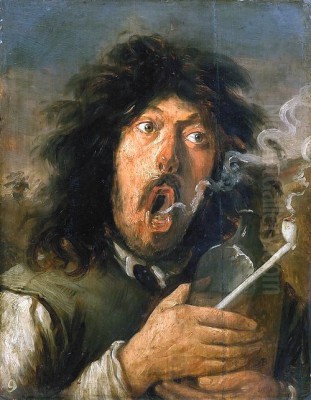
Joos van Craesbeeck stands as a fascinating figure in the rich tapestry of 17th-century Flemish art. Active during the Golden Age of painting in the Southern Netherlands, he carved a distinct niche for himself, primarily known for his lively and often raw depictions of peasant life, tavern interiors, and expressive character studies. Though perhaps overshadowed in popular recognition by contemporaries like Peter Paul Rubens or Anthony van Dyck, Craesbeeck's work offers a compelling window into the everyday world and psychological nuances of his time, bridging the gap between low-life genre scenes and more introspective portraiture. His own life story, marked by an unusual transition from baker to respected painter, adds another layer of intrigue to his artistic legacy.
From Bakery to Brush: An Unconventional Path
The origins of Joos van Craesbeeck are rooted not in an established artist's workshop, but in the village of Neerlinter, located in what was then the Duchy of Brabant, part of the Spanish Netherlands (now in Flemish Brabant, Belgium). Born around 1605 or 1606, his early life remains somewhat obscure until his documented presence in Antwerp. It was here that his life took a decisive and unexpected turn. Craesbeeck found employment as a baker, specifically supplying bread to the garrison and prisoners within the Citadel of Antwerp.
This seemingly mundane occupation proved pivotal. Within the citadel's walls, Craesbeeck encountered the renowned painter Adriaen Brouwer, who was imprisoned there, likely for debts or disorderly conduct, around 1633. Brouwer was already a celebrated artist, known for his innovative and highly expressive genre scenes, often depicting peasants carousing, drinking, and fighting with an unprecedented psychological intensity. A friendship developed between the baker and the incarcerated artist. Recognizing Craesbeeck's potential or perhaps simply seeking companionship and assistance, Brouwer took him on as a pupil.
This apprenticeship, born under such unusual circumstances, set Craesbeeck firmly on the path to becoming a painter. He quickly absorbed Brouwer's style and thematic interests. The close bond between the two men is well-documented; Craesbeeck was not only Brouwer's student but also his friend and likely assistant during and after Brouwer's release. This relationship would profoundly shape Craesbeeck's early artistic output.
Antwerp Beginnings and the Influence of Brouwer
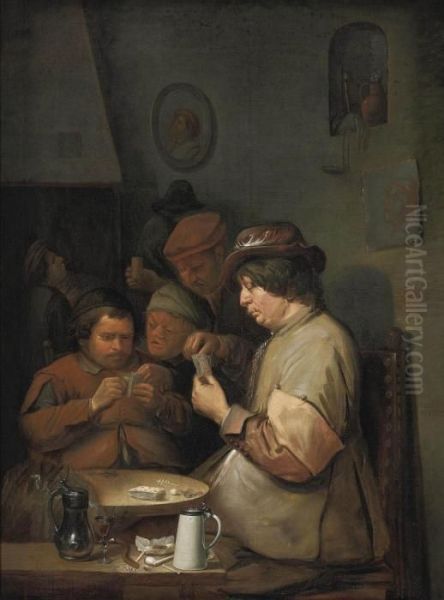
Following his informal training under Brouwer, Joos van Craesbeeck formally entered the Antwerp art world. He was registered as a master painter in the prestigious Guild of Saint Luke in Antwerp for the guild year 1633-1634. This official recognition marked his transition from an amateur or assistant to an independent professional artist. His early works from this period clearly demonstrate the strong influence of his teacher, Adriaen Brouwer.
Craesbeeck adopted Brouwer's preferred subjects: rowdy tavern scenes, smokers, drinkers, card players, and peasants engaged in various forms of revelry or conflict. He emulated Brouwer's dynamic compositions, his expressive, often caricatured figures, and his earthy color palette. Some of Craesbeeck's paintings from this time are so close in style and execution to Brouwer's that attribution has occasionally been debated by art historians. Both artists shared a fascination with capturing fleeting expressions and the unvarnished reality of lower-class life.
However, even in these early stages, subtle differences began to emerge. Some accounts suggest Craesbeeck's initial works leaned towards depicting even more explicitly coarse or violent aspects of peasant life than Brouwer typically did. He seemed particularly drawn to the dramatic potential of brawls and intense emotional states. There's also an interesting biographical note, mentioned in some sources, that Craesbeeck may have married Brouwer's former wife, which could have further complicated or solidified their personal and professional connection, although details remain somewhat unclear. Regardless, his time in Antwerp established his reputation as a skilled painter within the Brouwerian tradition.
Brussels Maturity and Stylistic Evolution
Around 1650 or 1651, Joos van Craesbeeck relocated from Antwerp to Brussels, the administrative and courtly center of the Spanish Netherlands. This move marked a new phase in his career and artistic development. In 1651, he was accepted as a master into the Brussels Guild of Painters, indicating his established status and intention to build his career in this new city. Brussels offered a different artistic environment compared to the bustling commercial hub of Antwerp, potentially exposing him to different patrons and influences.
During his Brussels period, Craesbeeck's style continued to evolve. While he still produced tavern and peasant scenes reminiscent of his earlier work and Brouwer's legacy, subtle shifts became apparent. Some scholars note a gradual move towards depicting slightly more refined settings, perhaps reflecting the tastes of a different clientele or his own changing interests. His focus might have broadened from exclusively low-life subjects to include scenes hinting at middle-class life or interiors that were less chaotic.
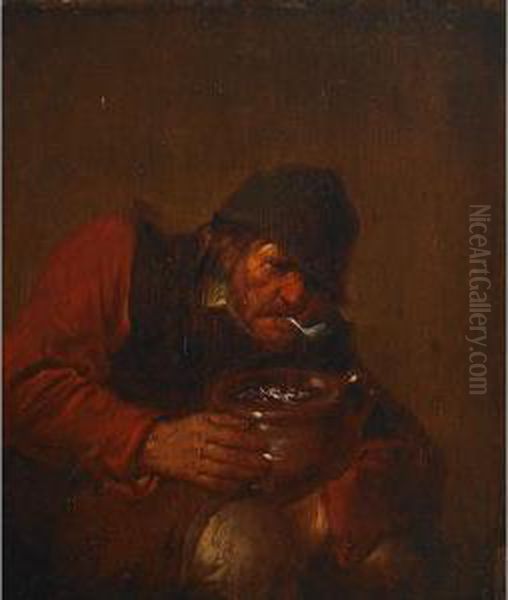
Furthermore, Craesbeeck seemed to refine his technique and deepen his exploration of human psychology. While Brouwer excelled at capturing raw emotion, Craesbeeck, in his mature phase, sometimes displayed a greater interest in nuanced expressions, subtle interplay between figures, and a more sophisticated handling of light and shadow to create atmosphere. He developed a recognizable manner, often using thin layers of paint and paying close attention to details of clothing and setting, such as the characteristic bearded men, women in distinctive hats or headscarves that populate his canvases. He became a respected figure in the Brussels art community.
Signature Themes: Taverns, Peasants, and Everyday Drama
The core of Joos van Craesbeeck's oeuvre lies in genre painting, specifically scenes of everyday life among the lower classes. Taverns were a favorite setting, serving as stages for a wide range of human activities and interactions. His paintings often depict drinkers raising their glasses, smokers puffing on clay pipes, intense card games, musicians playing simple instruments, and sometimes, arguments escalating into brawls. These scenes were not merely documentary; they often carried moralizing undertones, reflecting contemporary attitudes towards drinking, gambling, and idleness, yet they were rendered with an undeniable vitality and often a touch of humor or satire.
Works like The Smoker (sometimes identified as The Drinking Man) exemplify his focus on individual character types within these settings. These small-scale works often zoom in on a single figure, capturing a moment of indulgence or contemplation with expressive force. The act of smoking, relatively new and sometimes controversial in the 17th century, was a recurring motif for both Craesbeeck and Brouwer, allowing for detailed studies of facial expressions.
His depictions of peasant life extended beyond the tavern. He painted scenes of rustic interiors, families, and individuals engaged in simple activities. Card Players is another typical example, showcasing a group engrossed in their game within a dimly lit, humble interior. Craesbeeck excelled at creating a sense of immediacy and drama even in these small formats, using dynamic compositions and expressive figures to draw the viewer into the scene. His ability to convey the textures of rough fabrics, wooden furniture, and earthenware pottery added to the realism of his depictions.
Exploring Religious and Allegorical Subjects
While best known for his genre scenes, Joos van Craesbeeck also ventured into religious and allegorical themes, often infusing them with the same dramatic intensity and psychological focus found in his secular works. A notable example is The Temptation of Saint Anthony. This subject, popular since the late Middle Ages, allowed artists to explore themes of faith, sin, and the grotesque. Craesbeeck's interpretation clearly shows the influence of earlier masters like Hieronymus Bosch and Pieter Bruegel the Elder, known for their fantastical and often disturbing depictions of demonic torment.
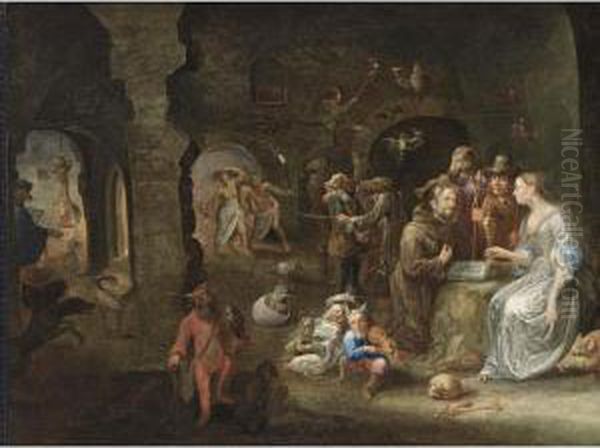
In Craesbeeck's version, Saint Anthony is besieged by monstrous creatures and seductive figures in a chaotic landscape. The painting showcases his skill in rendering imaginative and often bizarre details, combined with a dramatic use of light and shadow (chiaroscuro) to heighten the spiritual struggle. Some interpretations suggest that this work, like other religious paintings by Craesbeeck, might reflect personal experiences or anxieties, perhaps relating to temptation, vice, or the human condition – themes he explored frequently in his tavern scenes, albeit in a different context.
Another intriguing work is The Coin Collector, described as a monochrome painting symbolizing greed (Avarice). This indicates Craesbeeck's engagement with the tradition of allegorical representation, using everyday figures or activities to convey abstract moral concepts. This work, possibly part of a series depicting the Seven Deadly Sins (a theme also tackled by Brouwer, with Craesbeeck potentially involved in completing Brouwer's unfinished series), demonstrates his versatility and his ability to imbue seemingly simple scenes with deeper meaning.
Artistic Style: Light, Expression, and Detail
Joos van Craesbeeck's artistic style is characterized by several key elements, evolving throughout his career but retaining a distinct identity. His debt to Adriaen Brouwer is undeniable, particularly in his choice of subject matter, dynamic figure arrangements, and often rough, expressive brushwork in his early period. He adopted Brouwer's interest in capturing the "tronie" – studies of facial expressions or character types – which is evident in works like The Smoker.
However, Craesbeeck developed his own strengths. He became particularly adept at manipulating light and shadow to create mood and focus attention. His interiors often feature strong contrasts, with figures emerging from dimly lit backgrounds, enhancing the sense of drama or intimacy. Compared to Brouwer, some critics find Craesbeeck's later work to possess a slightly cooler palette and perhaps a smoother finish, although he maintained a lively touch.
He paid considerable attention to detail, rendering textures, clothing, and objects within his scenes with care. His figures, while sometimes caricatured, often display a convincing range of emotions, from boisterous laughter and drunken stupor to quiet contemplation or simmering anger. The small scale of many of his paintings invites close viewing, allowing the audience to appreciate the fine execution and the narrative details packed into each composition. His characteristic figures – often stocky, bearded men and women with distinctive headwear – become familiar presences across his body of work.
Relationships with Contemporaries: Collaboration and Context
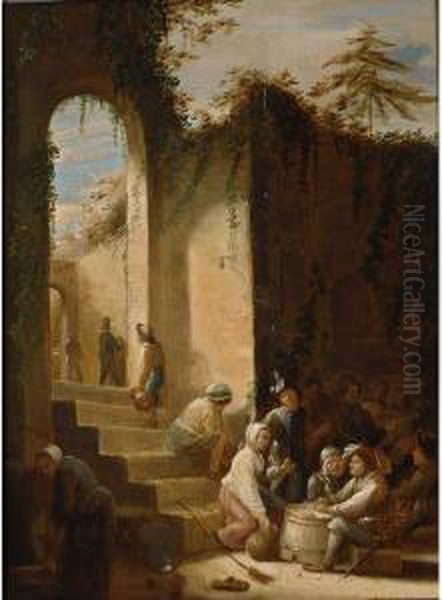
Joos van Craesbeeck operated within a vibrant artistic landscape in both Antwerp and Brussels. His most significant relationship was undoubtedly with Adriaen Brouwer, his teacher and friend. This connection was foundational, shaping his early style and subject matter. The influence was profound, leading to shared themes and sometimes overlapping attributions. Their collaboration may have extended to specific projects, such as the aforementioned Seven Deadly Sins series, where Craesbeeck might have completed works left unfinished by Brouwer after the latter's early death in 1638.
Beyond Brouwer, Craesbeeck was a contemporary of other major figures in Flemish genre painting. David Teniers the Younger, another highly successful and prolific painter of peasant scenes, taverns, and kermesses, was active during the same period, first in Antwerp and later as court painter in Brussels. While Teniers often depicted peasant life with a somewhat more idealized or picturesque quality compared to the rawness found in Brouwer and early Craesbeeck, their works collectively contributed to the popularity and development of genre painting.
David Ryckaert III was another contemporary specializing in genre scenes, often depicting artisans, alchemists, or musical companies, sometimes with allegorical overtones. Craesbeeck would have known the work of these artists, and they likely knew his. The relationship seems to have been one of mutual awareness and shared participation in a thriving market for genre pictures, rather than intense rivalry. They all drew inspiration from the legacy of Pieter Bruegel the Elder, the great 16th-century master of peasant scenes.
Craesbeeck also worked in the shadow of the towering figures of Flemish Baroque painting, Peter Paul Rubens and Anthony van Dyck, who dominated the Antwerp scene with their large-scale history paintings, religious commissions, and aristocratic portraits. While Craesbeeck's focus was different, the overall artistic energy and high standards of craftsmanship prevalent in Flanders undoubtedly influenced his environment. In Brussels, he would have been aware of painters like Gonzales Coques, known for his elegant small-scale group portraits, and Gillis van Tilborgh, another genre painter active in the city. Comparisons can also be drawn with Dutch genre painters like Jan Steen or Adriaen van Ostade, who explored similar themes of peasant life and taverns north of the border, albeit often with different stylistic nuances and cultural contexts. Frans Hals, the great Dutch portraitist, also shared an interest in capturing lively expressions, which resonates with the character studies of Craesbeeck and Brouwer.
Legacy, Collections, and Market Presence
Joos van Craesbeeck died around 1660 or possibly shortly thereafter (some sources mention 1662), likely in Brussels. He left behind a significant body of work that secured his place as an important figure in 17th-century Flemish genre painting. While perhaps not achieving the widespread fame of Brouwer or Teniers the Younger, his paintings were appreciated for their lively execution, psychological insight, and vivid portrayal of contemporary life. He successfully carried forward the Brouwerian tradition while developing his own distinct artistic personality.
His works entered collections relatively early on and continue to be found in museums and private hands today. Notable institutions holding his paintings include the Kunsthistorisches Museum in Vienna (e.g., Beggar Girl), the Agnes Etherington Art Centre at Queen's University in Kingston, Canada (A Man Surprised), and potentially the "Leerssen Museum" in Maastricht (Woman Playing Flute and Man Raising Glass in a Tavern), among others. Many works also reside in private collections, occasionally appearing on the art market.
Auction results for Joos van Craesbeeck's paintings vary depending on size, subject matter, condition, and provenance. Examples cited in the source material show prices ranging from a few thousand euros or pounds for typical genre scenes or works like The Temptation of Saint Anthony, indicating a steady but generally more modest market presence compared to the biggest names of the era. Nonetheless, the continued interest from collectors and museums underscores his recognized contribution to Flemish art history.
Conclusion: A Unique Voice in Flemish Genre Painting
Joos van Craesbeeck's journey from a baker in the Antwerp citadel to a respected master painter in Brussels is a testament to his talent and the unique circumstances that launched his career. Deeply influenced by his friend and teacher Adriaen Brouwer, he became a key practitioner of Flemish genre painting, specializing in animated tavern scenes, expressive character studies, and depictions of peasant life. His work is noted for its vitality, psychological depth, skillful handling of light, and often humorous or satirical edge.
While firmly rooted in the tradition established by Brouwer and ultimately tracing back to Pieter Bruegel the Elder, Craesbeeck developed his own stylistic nuances and thematic interests, including excursions into religious and allegorical subjects. He captured the rough-and-tumble energy of 17th-century Flemish popular culture with an unflinching eye, yet also demonstrated sensitivity in portraying individual emotions and atmospheric interiors. As a significant contributor to the rich genre painting tradition alongside contemporaries like David Teniers the Younger and David Ryckaert III, Joos van Craesbeeck remains an important artist whose works offer valuable insights into the art and society of his time.